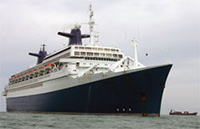Fabled ocean liner heads to scrapyard
by Michael Casey, Canoe (Canada)
 |
 |
 |
 |
| |
 |
|
| |
A cargo ship, right, passes the former S.S. France anchored in the open sea about 20 km off the west coast of Malaysia in March.
- (AP Photo/Andy Wong) |
|
 |
 |
 |
|
| |
12 May 2006 (Bangkok, Thailand) –
After sliding down the gangway in 1960, the SS France became one of the last great trans-Atlantic ocean liners, carrying the likes of artist Salvador Dali - and his pet ocelot - and taking the Mona Lisa to an exhibition in the United States.
Today, the rust-streaked ship is headed to an ignoble end at a wrecking yard in India - and a role as the latest symbol for health and environmental activists who are raising concerns about the safety of the long-ignored salvage business.
Activists contend the once-grand liner is full of asbestos and other toxic materials that will endanger the workers who will break it apart from stem to stern at one of the nautical graveyards dotting the shores of south Asia.
Similar protests in February led French authorities to cancel the dismantling of the French aircraft carrier Clemenceau in India after revelations that it also was loaded with asbestos and other substances now banned in the West.
Ship-breaking is a major business, supplying scrap steel and other materials to a region hungry for industrial materials. But critics say its workers, often poor migrants, face death or dismemberment from toxins, gas explosions and falling hunks of steel.
Port officials in Malaysia, where the France had been anchored in recent months, confirmed Tuesday that the ship had pulled up anchor and was being towed by a pair of tugs toward the shipwrecking centre of Alang on India's west coast.
Nazir Kaliwala, who owns International Shipping Co. in India, said he bought the ship for $14.4 million US and sold it to a ship-breaking company in Alang that he refused to identify. He said he expected the ship to arrive in a month.
The environmental group Greenpeace protested the move. The liner "carries over 900 metric tons of asbestos and is contaminated with other toxic material," said Rampati Kumar, a Greenpeace campaigner.
India's Environment Ministry had no comment.
The France never had it easy. It entered service in 1962, just as jet airliners started to become the primary mode of crossing the Atlantic.
Still, the liner was one of the fastest passenger ships and stretched 315 metres - so long it couldn't fit into the locks of the Panama Canal. Its avant-garde design, winding staircase, tuxedo-clad diners and fine cuisine came to symbolize luxury on the high seas.
The wife of French President Charles de Gaulle was on hand for the maiden voyage and the France travelled between Europe and New York hundreds of times.
"She was definitely a trendsetter," said Allan Jordan, a maritime historian who sailed on the France in the 1980s. "There were only a handful of ships that could give her competition. At this point, there are very few of them left."
But the France needed subsidies to stay in business, and the government cut off the aid in 1974. Its owner, the Compagnie General Transatlantique, retired the ship in 1974.
It was sold to an Arab sheik who talked of turning it into a floating museum before Norwegian Cruise Lines bought the liner in 1979.
That company rechristened the ship the SS Norway and spent nearly $80 million converting it into a pleasure cruiser with outdoor swimming pools and sun decks. For two decades, the Norway took 2,000 passengers at a time on weekly trips in the Caribbean.
In 2000, the liner was acquired by Star Cruises. It got a new name last year - Blue Lady - but it hadn't carried passengers since a boiler explosion killed eight crewmen in 2003.
Repairs proved too costly to keep the ship in service. Star Cruises recently confirmed that the ship had been sold, but refused to provide details.
Bangladesh, another ship-breaking centre, ruled in February that the liner couldn't be broken up in that country until it was decontaminated - a procedure which has not yet been carried out.
Supporters in recent years set up websites devoted to saving the France. Some had sailed on the ship 50 times. Others met their spouses aboard. They suggested transforming it into a floating hotel, casino or hospital and even petitioned the U.S. Congress for help.
All efforts were unsuccessful.
"Sadly, there are so many things stacked against her at the moment that there is little hope for a future where she can be at sea where she belongs," said Devon Scott, the ship's former historian.
FAIR USE NOTICE. This document contains copyrighted material whose use has not been specifically authorized by the copyright owner. The Basel Action Network is making this article available in our efforts to advance understanding of ecological sustainability and environmental justice issues. We believe that this constitutes a 'fair use' of the copyrighted material as provided for in section 107 of the US Copyright Law. If you wish to use this copyrighted material for purposes of your own that go beyond 'fair use', you must obtain permission from the copyright owner.
More News
|